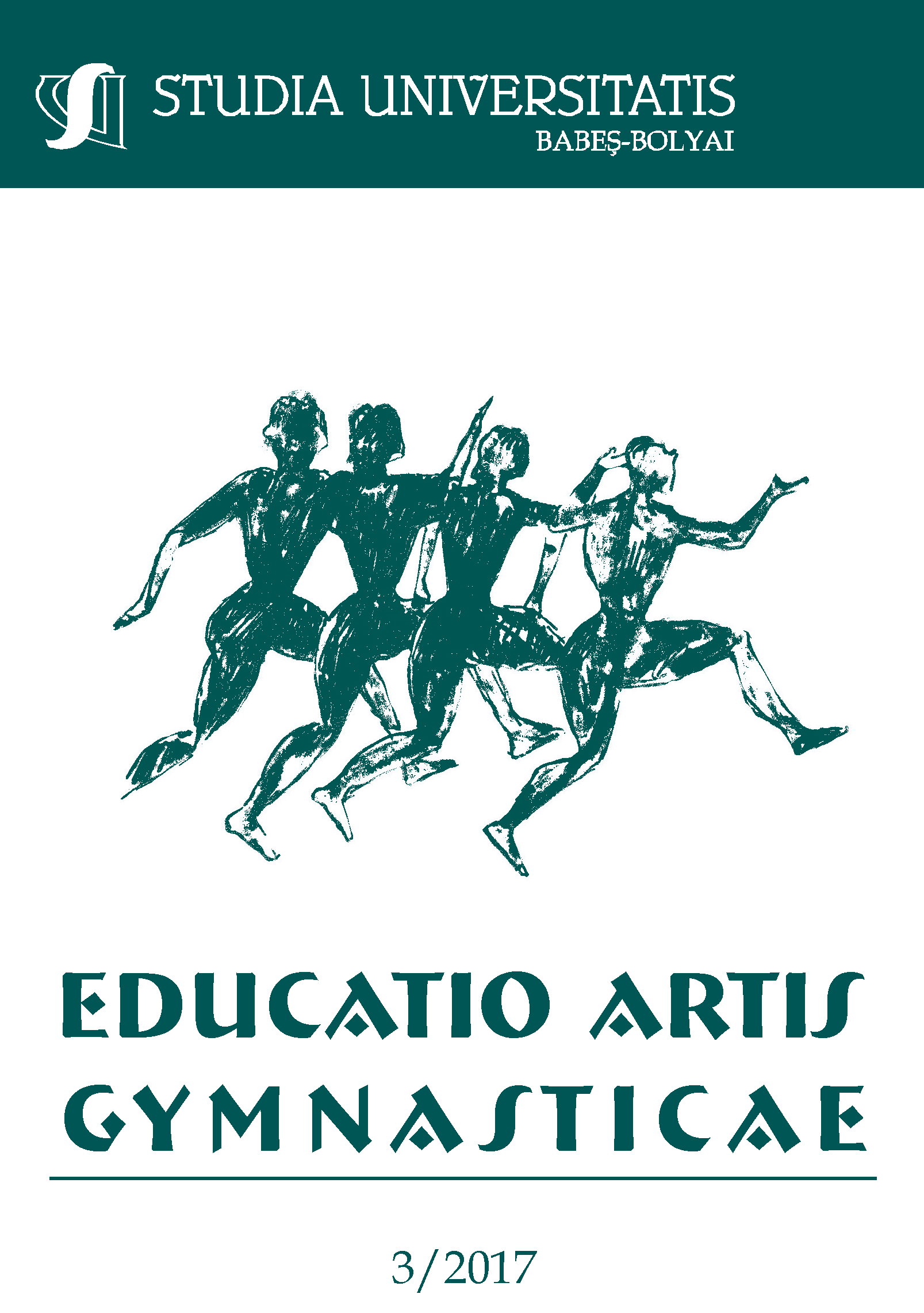THE DECLARED GOALS OF PRACTICING PHYSICAL AND SPORTS ACTIVITIES BY THE STUDENTS OF BABES-BOLYAI UNIVERSITY FROM CLUJ-NAPOCA ACCORDING TO GENDER AND FACULTY PROFILE
DOI:
https://doi.org/10.24193/subbeag.62(3).26Keywords:
sport, physical activity, health, gender, faculty profile.Abstract
This study aims at highlighting the purposes for which UBB Cluj-Napoca students practice physical and sports activities, depending on the gender and profile of the faculty they are studying. Statistical data was obtained by applying a questionnaire to a total of 465 students from 13 faculties. The respondents' age was between 18 and 40, with most students aged 19-21. The conclusions drawn from the statistical analysis of the comparison of the factors of purpose to practice physical and sports activities show that there are significant differences between the sexes. For girls, the goal is health, and for boys, performance and participation in competitions, the social goal, is a bit more important for boys than for girls, but the difference is not significant. Students from Physical Education and Sports appreciate the physical movement both from the competitive point of view, as well as for the health and social. Students with specialization in socio-human sciences have appreciated the factors for improving and maintaining the health status and the socialization factor. Students at the Faculty of Orthodox Theology have chosen sport as important for the competitive and social factors, and those in the exact sciences faculties consider the practicing of sport is important to measure forces through competition and achieving performance.
REZUMAT. Scopurile declarate ale practicării activităților fizice și sportive de către studenții Universității Babeş-Bolyai din Cluj-Napoca în funcție de gen și profilul facultății la care studiază. Studiul de față urmărește evidențierea scopurilor pentru care studenții UBB Cluj-Napoca practică activitățile fizice și sportive, în funcție de gen și profilul facultății la care studiază. Datele statistice au fost obținute în urma aplicării unui chestionar pe un număr de 465 de studenți din 13 facultăți. Vârsta respondenților a fost cuprinsă între 18 și 40 de ani, majoritatea studenților având vârsta cuprinsă între 19 – 21 de ani. Concluziile rezultate din analiza statistică de comparare a factorilor scopurilor de a practica activitățile fizice și sportive arată că există diferențe semnificative între sexe. Pentru fete, primează scopul sănătate, iar pentru băieți obținerea performanței și participarea la competiții, scopul social, este puțin mai important pentru băieți, decât pentru fete, dar diferența nu este semnificativă. Studenții de la specializarea educație fizică și sportivă, apreciază mișcarea fizică atât din punct de vedere competițional, cât și al sănătății, dar și social. Studenții cu specializare în științele socio-umane au apreciat factorii scop de îmbunătățire și menținere a stării de sănătate și factorul socializare. Studenții de la Facultatea de Teologie Ortodoxă au ales practicarea sportului ca importantă pentru factorul competițional și cel social, iar cei din facultățile cu profil real consideră practicarea sportului importantă pentru măsurarea forțelor prin întrecere, prin competiție, și pentru atingerea performanțelor.
Cuvinte cheie: sport, activitate fizică, sănătate, gen, profil.
References
Carter, N. (2012). Sport as Medicine: Ideas of Health, Sport and Exercise. In Medicine, Sport and the Body: A Historical Perspective (pp. 13–35). London: Bloomsbury Academic. http://dx.doi.org/10.5040/9781849662062.ch-001.
Demeter, A., Drăgan, I., (1990). Sport şi sănătate, Bucureşti Ed. Sport-Turism.
Fountaine, C.J., Liguori, G.A., Mozumdar, A., Schuna Jr., J., (2011). Physical Activity and Screen Time Sedentary Behaviors in College Students, International Journal of Exercise Science, http://www.intjexersci.com. Int J Exerc Sci 4(2): 102-112.
Hagan JF, Shaw JS, Duncan PM, eds. (2008). Bright Futures: Guidelines for Health Supervision of Infants, Children, and Adolescents, Third Edition. Elk Grove Village, IL: American Academy of Pediatrics.
Haskell, W.L et. al, (2007). Physical Activity and Public Health: Updated Recommendation for Adults From the American College of Sports Medicine and the American Heart Association, Circulation, No.116:1081-1093.
Hoye, Russell., Nicholson, Matthew, Houlihan, Barrie. (2010). Sport and Policy. Elsevier Ltd.
Judge, L., Bellar, D., Lee, D., Petersen, J., Wanless, E., Surber, K., Ferkel, R., Simon, L., (2012). An Exploratory Study of Physical Activity Patterns of College Students at a Midwest State University in the United States, The Sport Journal http://thesportjournal.org.
Kilpatrick, M., Herbert, E., Bartholomew, J., (2005). College students’ Motivation for Physical Activity: Differentiating Men’s and Women’s Motives for Sport Participation and Exercise. Journal of American College Health, vol. 54, nr. 2.
Lindstrom,M., Hanson,B.& Ostergren, P. (2001). The socioeconomic differences in leisure time physical activity: The role of social participation and social capital in shaping health related behaviour. Social Science and Medicine, 52, 441-451.
McArthur, L.H., & Raedeke, T.D. (2009). Race and sex differences in college student physical activity correlates. American Journal of Health Behavior, 33(1), 80-90.
Nistor, L., Tîrhaş, C. (2013). Consumul reflexiv. Aspecte cu privire la relaţia conflictuală dintre principiilere flexive şi constrângerile economice. În P. Iluţ (coord.). În căutare de principii. Epistemologie simetodologie social aplicată (pp. 251-280). Iaşi: Ed. Polirom.
Nordqvist, C. (2013). „What Is Health? What Does Good Health Mean?” Medical News Today. Retrieved from: http://www.medicalnewstoday.com/articles/150999.php.
Pehoiu, C., Pehoiu, A., (2010). Physical activities and promoting a healthy life style in new social and economic conditions International, WSEAS International Conference on Environment, Medicine And Health Sciences, ISSN: 1790-5125, ISBN: 978-960-474-170-0.
Pop C.-E., (2010). Starea de sănătate a populaţiei din România în context European. O abordare din perspectiva calităţii vieţii, Calitatea Vieţii, XXI, nr. 3–4, p. 274–305.
Promoting Mental Health As A Public Health Priority (2014). A Report of the World Health Organization Department of Mental Health and Substance Abuse in collaboration with the Victorian Health Promotion Foundation and The University of Melbourne, Forty-eighth edition.
Whitehead J., Telfer H., Lambert J., (2013). Values in Youth Sport and Physical Education. Routledge.
USA Centres for Disease Control and Prevention. Adolescent and School Health. Web. http://www.cdc.gov/healthyyouth/physicalactivity/facts.htm.
Downloads
Published
How to Cite
Issue
Section
License
Copyright (c) 2017 Studia Universitatis Babeș-Bolyai Educatio Artis Gymnasticae

This work is licensed under a Creative Commons Attribution-NonCommercial-NoDerivatives 4.0 International License.



